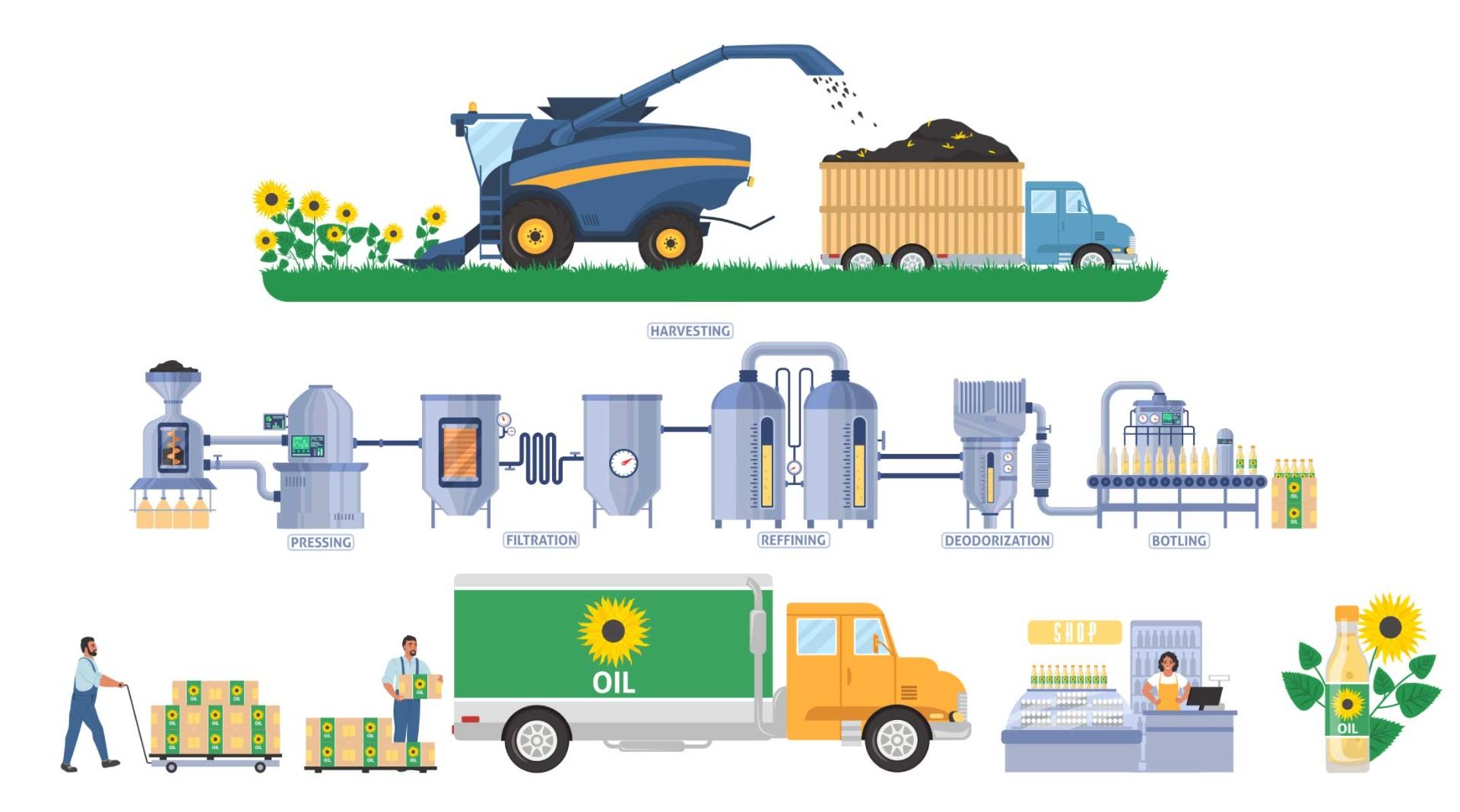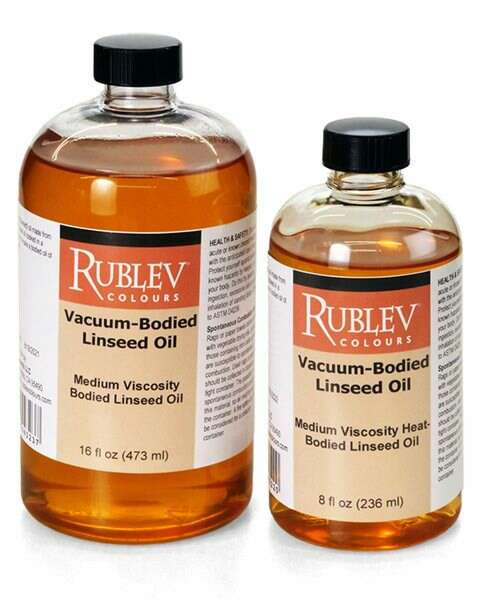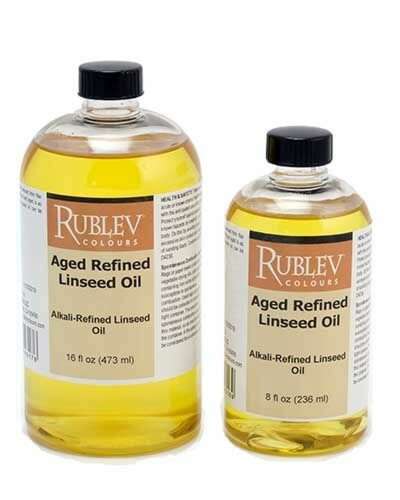
There’s a bewildering array of drying oils for oil painting. Where do all the different drying oils come from? How are they different? And how do you choose the right one for your painting?
Although there are many brands and types of drying oils for oil painting, there are relatively few oil refiners. Artists’ materials manufacturers do not process their oil but purchase it in bulk from large industrial refiners. For example, there are two significant producers of linseed oil in North America and several more in Europe. Still, many more brands of drying oils are offered by artist materials companies. Artist materials companies do not have the resources to process linseed oil, a very specialized and large-scale industry today.
A drying oil is an oil that hardens to a tough, solid film after exposure to air. The oil hardens through a chemical reaction in which the polymers cross-link (hence, polymerize). This is different from other painting mediums, such as watercolors, acrylics, gouache, etc., that dry by the evaporation of water or other solvents.
Drying oils used in artist paints are produced from oilseeds, such as flax, poppy, and safflower plants, and nuts, such as walnuts. The oils are produced both for edible purposes and industrial uses. More than 90 percent of the world’s production of oils is used in edible products. Most processing steps aim to convert crude oils from their undesirable physical form into refined products that meet the requirements of consumers.
Pressing
To liberate oils from oil-bearing seeds and nuts, the cell walls are broken by grinding, rolling, or pressing under high pressure to liberate the oil. The general sequence of everyday operations in pressing oilseeds and nuts is as follows:
- Seeds are passed over magnetic separators to remove stray bits of metal that may have entered during harvesting operations;
- The shells or hulls are removed;
- The kernels or meats are converted to a coarse meal by grinding them between grooved rollers or in hammer mills;
- They are pressed in hydraulic or screw presses with or without preliminary heating, depending on the type of oil-bearing material and the quality of oil desired.
Oil expressed without heat contains the least impurities and is often of edible quality without refining or further processing. Such oils are known as cold-pressed or virgin oils. Pressing the coarse meal while heating removes more oil and significant quantities of impurities such as phospholipids, color bodies, and unsaponifiable matter. Such oil is more highly colored than cold-pressed oils. The seed cakes or meals are high-quality protein sources used in animal feeds.
Development of Oil Pressing
The Greeks and Romans used screw presses, which closely resembled in design the winepress, in the pressing of olive oil. The screw press persisted for centuries and may still be used in small pressing operations. In the seventeenth century, the Dutch “stamper” press was invented and used almost exclusively in Europe for pressing oilseeds until the early nineteenth century, when the hydraulic press was developed. Although, in principle, it resembled the ancient wedge press, it played an essential part in the industry, persisting in use even some considerable time after the development of the hydraulic press.
The Dutch Press
The Dutch press comprised an oblong wooden or cast-iron box containing a perforated double bottom. A bag filled with the meal was placed between perforated iron plates at each end of the box. The space between the two bags was filled with wooden blocks and wedges. Over the box was erected a framework on which a roughly squared timber beam was swung. This beam was lifted and allowed to fall on one of the wedges in the box using a revolving shaft. About fifteen blows a minute were delivered onto the wedge. When the pressing was completed, a blow delivered on a second and inverted wedge loosened the blocks and bags in the box.
The Hydraulic Press
The development of the hydraulic press by Joseph Bramah was widely used in the oilseed industry early in the nineteenth century. The first hydraulic oil presses were little more than Dutch presses in which hydraulic power was substituted for that obtained from wedges and a falling weight. Later press designs employed plates between which the seed cakes were pressed, later revised into the “screw press” or “cage press.”
A screw press presses oil seeds through a caged barrel-like cavity. Seeds enter one end of the cage, and waste products exit the other. The press uses friction and continuous pressure from the screw drives to move and compress the seed. The oil seeps through small openings that do not allow seed fiber to pass through. Afterward, the seeds are pressed into a solid cake, which is removed from the machine.
Processing Crude Oil
The crude oil obtained from expellers and solvent extraction contains impurities such as mucilage, gums, and unfiltered proteinaceous matter from the seed. It also contains gums, which makes it unfit for edible and industrial purposes.
The crude oil is refined by the following processes.
-
Degumming
-
Neutralizing
-
Bleaching
-
Dewaxing
-
Deodorizing
The first refining stage separates the gums and foreign impurities with chemicals and hot water, known as degumming or de-sliming.
Next, the degummed oil is neutralized with water containing an alkali, such as sodium hydroxide (lye), to remove free fatty acids.
After that, the degummed oil is further processed by bleaching under a vacuum and filtering through Fuller’s earth or diatomaceous earth and carbon to reduce colored bodies. This bleaching yields a very pale-colored oil.
Removing the thin layer of wax that covers each seed is the last stage of the refinement process. Dewaxing is done by cooling the oil to 4° C. The cooled oil is held at this temperature until the waxes crystallize, which is then removed by mechanical filtration.
The natural odor of the oil may be removed through vacuum steam distillation in the case of some edible oils.
The oil is refined to remove phosphatides and gums naturally occurring in the seed. Subsequent refining through post-gumming with sulfuric acid and phosphoric acid yields an oil with virtually no traces of phosphatides or gums.

Raw Oil
Raw linseed oil is linseed oil that has been extracted without any processing. It takes much longer to dry than refined linseed oil. The former needs several weeks to cure, while 36–48 hours is the cure time for the latter.
Cold-pressed oil is considered the best among artists because of the belief that it forms a better quality oil. This is a belief held on by many artists but not shared by paint technologists and manufacturers. Refined and aged oil makes a better oil vehicle for paint making than cold-pressed unrefined or raw oil because refined oil does not contain “breaks,” combined water, waxes, and other impurities that may cause the oil to yellow with age. The reason why cold-pressed linseed oil is recommended in artists’ literature is due to one fact: cold-pressed linseed oil has a high acid value compared to ordinary alkali-refined linseed oil. High acid value makes drying oil better for grinding pigments. Until the last hundred years, only cold-pressed oils had a high acid number considered suitable for grinding colors. However, during the last hundred years, manufacturers have produced high acid-value refined oils and even high acid-value stand or polymerized oils. Natural Pigments uses high acid refined and aged linseed oil in many of its Rublev Colours Artists Oils and offers these oils to artists for making their paint through the Natural Pigments online store.
Bodied (Stand) Oils
Linseed oil heated to about 300° C. under conditions that exclude oxygen is called “bodied oil.” The oil polymerizes— that is, it changes its molecular structure while retaining its chemical ingredients. It has a lower iodine number than the cold-pressed oil, dries slowly, yellows less than the other unbodied oils, and forms a tough, strong film. It imparts an enamel-like smoothness to the paint and tends to make it fuse and blend. Because of its heavy consistency and low acid number, it is used as an ingredient in painting mediums rather than as a grinding oil or binder.
Non-conjugated and conjugated drying oils like linseed and Tung oil can be polymerized by heating in an inert atmosphere. These polymerized oils are then referred to as bodied oils. To achieve the higher viscosities of bodied oils, non-conjugated oils are heated to 320° C. and conjugated oils to 240° C. This increase in viscosity, or “body,” is caused by the thermal decomposition of naturally occurring hydroperoxides. This decomposition yields free radicals that contribute to a limited amount of cross-linking.
Stand oil is a misnomer in the industry today, and the term is used mainly by artist materials companies selling heat-bodied oil to artists. The term “stand oil” originated in the eighteenth century to denote oil purified by heating it and then allowing it to stand for some time, thereby letting “foots” or impurities in the oil settle. Today, linseed oil-producing firms offer numerous linseed oil products, such as polymerized, maleanized, boiled, aged, blown, conjugated, etc. These exciting products offer a wide range of performance variables not typically offered to the artist.
Before the nineteenth century, oil was exposed to sunlight in open containers to thicken and polymerize it. This method was replaced in the eighteenth century by heating oil in closed containers, standing the oil for long periods to allow the impurities in the oil to settle, and finally decanting the oil. Stand oil was likely developed by the Dutch in the nineteenth century. When oil is polymerized, the molecules are connected in chains (polymers) by heating or oxidation. Oxidative polymerization is the initial stage of the drying process, so these polymerized oils dry faster. Heat-polymerized oils have higher viscosity (thicker) but dry more slowly than unrefined oils (linseed, poppy, or sunflower).
Bodied oils cannot be used alone because of their vicious nature, but they are an excellent addition to paint and mediums. The statement, “It is not a good binder because it is too viscous...” means that bodied oils do not alone make a suitable paint binder. It isn’t easy to wet pigments with highly viscous oil. Bodied oils produced in a vacuum have low free fatty acid values. Higher acid values make wetting very fine pigments easier, like most modern synthetic pigments. However, most paint manufacturers combine oils to obtain the best properties for their paint. For example, Natural Pigments combines bodied oils with aged oil in Rublev Colours Artist Oils. We do this to reduce drying time, increase viscosity, avoid pigment separation without using stearates and other additives, and make a “longer” paint.
Bodied oils yellow less than most other types of linseed oil and have good leveling properties. Its film gives a smooth, enamel-like surface without brushmarks.
Oxidized Oils
Oxidized oils dry faster but yellow more than bodied oils. They also produce a smooth, glossy finish, whereas raw oils produce a matt sheen from the natural expansion during polymerization. This expansion creates a finely textured surface that appears to the naked eye as a matte finish.
Boiled Oils
Boiled linseed oil has been altered by adding metal driers (chemical drying catalysts) to the oil while being heated or processed. This treatment allows the manufacturer to reduce the paints’ volatile organic compounds (VOC) content while maintaining the viscosity. Boiled linseed oil is often mixed with 10–15% bodied oil.
Blown Oils
Bodied oils are drying oils with increased viscosity produced by heating the oil with oxygen. To increase the viscosity of the boiled oil, the air is “blown” through the oil at 60–100° C. Blown linseed oils are polymerized by oxidation to increase the viscosity and acid number. They are used in non-penetrating finishes and dry faster than heat-bodied linseed oils.
References
Chalmers, Thomas Wightman, The Production and Treatment of Vegetable Oils: Including Chapters on the Refining of Oils, the Hydrogenation of Oils, the Generation of Hydrogen, Soap Making, the Recovery and Refining of Glycerine, and the Splitting of Oils, D. Van Nostrand Company, 1918, p. 56.
Gettens, R.J. and Stout, C.L., Painting Materials, Van Nostrand, New York, 1952, p. 42. Mayer, Ralph, The Artists Handbook, Viking Press, New York, 1970, p. 175.
Kay, Reed. The Painters Guide to Studio Methods and Materials. Englewood Cliffs, NJ: Prentice-Hall, Inc., 1983. p. 34.
Phillips, Morgan W. “Problems in the Reconstruction and Preservation of Old House Paints,” Proceedings of the North American International Regional Conference, Smithsonian Institution Press, Washington, D.C., 1976, p. 273.
Levison, Henry W., Artists Pigments, Hallandale, FL, 1976, p. 31.
Levison, Henry W., Color, Research and Application, Vol. 3, No. 1 Spring 1978, p. 7.
Levison, Henry W., “Yellowing and Bleaching of Paint Films,” Journal of American Institute for Conservation, 1985, Vol. 24, No. 2, Article 2 (p. 69–76) See online.
Rakoff, H., Thomas, F.L., and Gast, L.E., Journal of Coating Technology, 51, No. 649, 1979, p. 23.
Tahk, Christopher, “The Recovery of Color in Scorched Oil Paint Films,” Journal of the American Institute of Conservation, Vol. 9, No. 1, Fall 1979, p. 3.
See reference 3, p. 10.
ASTM Test Method D 1644, Non-volatile Content of Vehicles.
Mayer, Ralph, The Artists Handbook, Viking Press, New York, 1970, p. 216.
ASTM Test Method D 1925, Yellowing Index of Plastics.
See reference 6, p. 5.
See reference 3, p. 31.
Huey, S.J., “Low Temperature Storage of Colored Standards Panels,” Color Engineering, September–October 1965 pp. 24–27.










